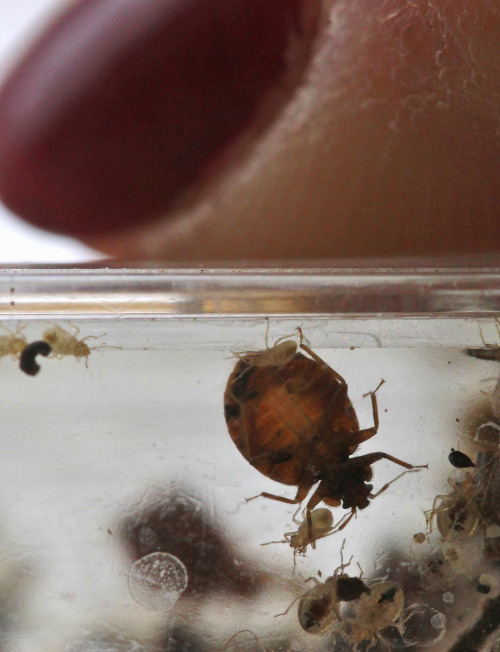PITTSBURGH (AP) _ Bedbugs aren't just sleeping with you. They're sleeping with each other.
Researchers now say that the creepy bugs have a special genetic gift: withstanding incest.
It turns out that unlike most creatures, bedbugs are able to inbreed with close relatives and still produce generally healthy offspring. That means that if just a few bedbugs survive in a building after treatment, they repopulate quickly.

Coby Schal and Ed Vargo are entomologists at North Carolina State University, and they presented preliminary research on genetic diversity in bedbug populations on Tuesday in Philadelphia, at the annual meeting of the American Society of Tropical Medicine and Hygiene.
``We kept discovering the same thing. Within a given apartment, or even a given building, there was extremely low genetic diversity,'' said Schal. ``In most cases there's just a single female that founded the population.''
Schal said that was a surprise, since an animal or insect population with limited diversity will usually build up and then crash, because genetic defects tend to magnify with inbreeding.
``But somehow bedbugs are able to withstand the effects of inbreeding, and do quite well,'' he said.
Bedbugs are wingless, reddish-brown insects that bite people and animals to draw blood for their meals. Though their bites can cause itching and welts, they are not known to spread disease.
The new research is important, said Zachary Adelman, an entomologist at Virginia Tech University who wasn't part of the North Carolina State team.
``No one had looked at these things,'' he said of the genetic makeup of bedbugs. ``It's pretty exciting.''
The researchers also found that while the community within a building tends to be similar, there are many different strains of bedbugs throughout the East Coast, suggesting that new colonies also get introduced through foreign travel or commerce.
``That means they're coming into the country from lots of different places,'' which means that the bedbug problem isn't going to stop anytime soon, said Adelman.
The findings may also help explain another part of the bedbug boom.
Bedbugs _ and other insects _ develop resistance to insecticides. Schal said that if a treatment kills anything less than 100 percent of the bugs, the survivors will not only repopulate, but pass on the resistance they've developed to future generations.
``The insecticides really need to be robust'' to do the job, Schal said.
Another researcher notes that you have to discover a problem before you can treat it.
Rajeev Vaidyanathan of SRI International, a nonprofit research firm with headquarters in Silicon Valley, said he's working on a quick, easy test so people can discover bedbugs before they get bitten.
Vaidyanathan said current technology comes down to spotting live or dead bedbugs, or using dogs to sniff them out.
``Both are often ineffective and tedious,'' he said.
So Vaidyanathan is trying to developing a biochemical test to identify bedbug-specific proteins that they leave behind, even when only a few bugs are present. Homeowners would swab a section of their home, and dip it in a special compound.
``A home pregnancy kit type of read-out. If there's a color change, you have a bug,'' he said, but it's too early to say when or if the idea will make it to market.
Vaidyanathan also pointed out some other forces behind the spread of bedbugs.
``The problems we are seeing with bedbugs in North America did not happen overnight,'' said Vaidyanathan. ``We have the highest concentration in the history of our species of humans living in cities. Bedbugs do not have wings; they are nest parasites, so our own population density has helped them to thrive.''
<한글기사>
빈대, 근친교배해도 자손 번창
빈대는 근친교배를 거듭해도 아무 이상이 없이 대대로 번창하는 유전적 특이성을 가진 것으로 밝혀졌다.
미국 노스캐롤라이나 스테이트 대학 연구진은 아무리 방제 작업을 벌여도 금방 무섭게 불어나는 빈대의 생태를 알아보기 위해 빈대의 유전자를 분석한 결과 놀라울 정도로 다양성이 낮다는 사실을 발견했다고 미국 열대의학 및 위생학회 연례회의에 서 발표했다.
연구진은 "연구를 거듭해도 똑같은 사실이 발견됐다. 특정 아파트, 심지어 빌딩 전체에서조차 개체군의 시조는 단 한 마리의 암컷으로 나타났다"고 밝혔다.
학자들은 동물이나 곤충의 경우 다양성이 제한되면 근친교배로 인해 유전적 결 함이 점점 커져 개체군이 형성됐다가 붕괴되는 것이 보통인데 빈대의 경우는 그 반 대여서 놀랍다고 말했다.
연구진은 또 한 건물 안의 빈대 개체군은 유전적으로 동일한 경향을 갖고 있음 에도 불구하고 미국 북동부 해안지대 전역의 빈대 변종들을 보면 외국 여행이나 교 역 등을 통해 새로운 군집이 유입되고 있는 것으로 나타난다고 밝혔다.
이들은 "이는 빈대들이 수많은 지역에서 들어오고 있음을 보여주는 것"라면서 이는 빈대 문제가 가까운 시일 안에 해결되지 않을 것임을 의미한다"고 말했다.
연구진은 북미 지역에서 최근 폭발적으로 나타난 빈대 문제는 하룻밤 사이에 일 어난 것이 아니라고 지적했다. 이들은 "북미 지역은 인류 종(種)이 역사상 가장 높 은 밀도로 모여있는 곳이다. 빈대는 날개가 없는 번식기생충이므로 인구 밀집 사태 가 이들의 번성을 가져온 셈"이라고 말했다.










![[Today’s K-pop] BTS pop-up event to come to Seoul](http://res.heraldm.com/phpwas/restmb_idxmake.php?idx=644&simg=/content/image/2024/04/17/20240417050734_0.jpg&u=)
![[Graphic News] More Koreans say they plan long-distance trips this year](http://res.heraldm.com/phpwas/restmb_idxmake.php?idx=644&simg=/content/image/2024/04/17/20240417050828_0.gif&u=)
![[KH Explains] Hyundai's full hybrid edge to pay off amid slow transition to pure EVs](http://res.heraldm.com/phpwas/restmb_idxmake.php?idx=644&simg=/content/image/2024/04/18/20240418050645_0.jpg&u=20240419100350)




![[KH Explains] Hyundai's full hybrid edge to pay off amid slow transition to pure EVs](http://res.heraldm.com/phpwas/restmb_idxmake.php?idx=652&simg=/content/image/2024/04/18/20240418050645_0.jpg&u=20240419100350)

